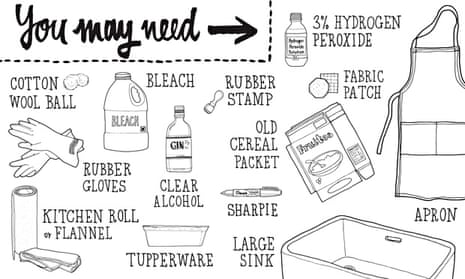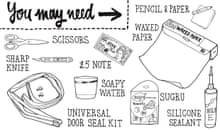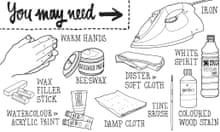If you have ever accidentally splashed bleach on your clothes in a cleaning frenzy, then you will be pleased to know that all is not lost. There are several ways to rescue your clothes, depending on the size of the bleach stain and the colour of the clothing.
Removing or erasing the bleach stain
Bleach effectively removes the colour from the cloth, so trying to remove the stain is difficult, although not impossible. If you have a couple of small spots, on a dark coloured garment, then it is worth trying the method below.
You will need:
Clear alcohol (gin or vodka)
A cotton wool ball
1) Apply a good swig of alcohol to your cotton wool ball.
2) Hold the damaged area and rub the stain, and the area around it, with the alcohol-soaked ball. The original colour of the garment will spread into the bleached area. Keep rubbing until the colour has spread across the area.
3) Rinse well in cold water.
Bleaching the whole garment
If it’s a big stain, then you could always bleach the whole item of clothing. You could be forgiven for thinking that would just involve dunking the whole thing in bleach, but the bleach continues to work even after rinsing, and will eventually cause the fabric to rot. It is therefore necessary to use something to neutralise the bleach such as hydrogen peroxide.
You will need:
Bleach
Rubber gloves
A large sink
3% hydrogen peroxide
An apron
1) Fill the sink with cold water, and soak your garment in the water.
2) Put on the rubber gloves and apron (to prevent any more mishaps) and add a cap’s worth of bleach to the mix – it is better to start off with less, and add more if needed, than be too exuberant in the beginning.
3) Swoosh your garment around, until the desired colour is reached (you can always add more bleach if necessary).
4) Let the water drain out of the sink and rinse the garment well in cold water.
5) Refill the sink with cold water, add the garment, and then add about 50g hydrogen peroxide for every 4-5 litres of water.
6) Allow your garment to soak for about half an hour, before rinsing again and drying.
Colouring in the bleach stain
Sharpie produce special Rub-a-Dub laundry pens. If you have a black garment, and again, if it is a small spot, then this would be a quick and easy fix. You can also use regular Sharpies (available in a wide range of colours) but need to “fix” the pen colouring on to the fabric (ironing on low, or tumble drying on low will usually do this).
Incorporating the stain into a new pattern
You can tie-dye using bleach, or you can use stamps dipped in bleach, to stamp a whole new motif on to your damaged clothing.
You will need:
A rubber stamp with a design of your choice
A small Tupperware tub
Kitchen roll or flannel
Rubber gloves
An apron
An old cereal packet
3% hydrogen peroxide
1) Place the cardboard in between the front and back sides of your garment. This prevents you accidentally bleaching both layers at once.
2) Lay your kitchen roll or flannel in the bottom of the Tupperware tub and add just enough bleach to soak it.
3) Pop on the gloves, and then lightly press the stamp into the bleach-soaked kitchen roll.
4) Press down firmly on to your garment, and lift cleanly.
5) Repeat as desired. Once you are happy with your design, neutralise the bleach by following the instructions above (see “bleaching the whole garment”).
Covering up the stain
A good old-fashioned patch can be a good way of achieving a “visible mend” and making a feature of the damaged area. You could try out patching with small hexagons to create a patchwork effect, or hand sewing a vintage fabric doily over the afflicted area.
Interested in finding out more about how you can live better? Take a look at this month’s Live Better challenge here.
The Live Better Challenge is funded by Unilever; its focus is sustainable living. All content is editorially independent except for pieces labelled advertisement feature. Find out more here.








Comments (…)
Sign in or create your Guardian account to join the discussion